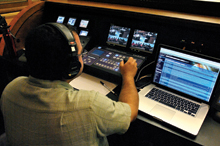A Window On the Technology in South Hall

The adage used to be that the school isn't just the building—it's the people who work inside the building.
But these days, something else better work inside the building, too: technology. Lots of it.
The five full classrooms in the Law School's new South Hall are up to the challenge. All five are packed with high-tech features, including touch-panel control systems, document cameras, a larger touch screen that allows professors to annotate documents projected on video screens, and more.
It all starts with a small panel on the professor's desk that controls most of those features.
Say Professor John Pottow is teaching a bankruptcy class. He can use his small touch panel to choose to project his notes on a large screen in the center of the room or a smaller screen off to one side. (In some rooms the whole class actually could videoconference with the petitioner, but more on that later.) The same touch panel dims the lights, turns on the correct projector, and closes the drapes—all with the brush of a finger on the control panel's screen.
The technology doesn't end there.Professor Pottow, it turns out, brought a presentation on a flash drive. He can plug the drive into a computer and display his slides on whichever screen he prefers. And if he wants to emphasize a particular bullet point, he can just underline it onscreen by swiping his finger across the second touch screen—a 17-inch version known as an "annotation panel."
Other classroom features will enable Pottow to place a paper document—a photocopy of a poorly worded court order, say, or a faulty motion—on the room's document camera, then slash away at it using his finger on the annotation panel. (He could also use a good old-fashioned pen; either way, the notations will end up on the video screen.) Think old-fashioned overhead projector, minus the transparencies and grease pencils.
South Hall's seven seminar/conference rooms share similar gear. But some classrooms feature more specialized equipment. One large and one medium-size classroom—seating about 148 and 100 students, respectively—are fully outfitted for videoconferencing. They're also set up for distance learning, meaning they're equipped with a microphone for every two students, enabling all to participate in classroom discussions with students and instructors at the remote location.
In more specialized areas of the building, different equipment is used. The clinical suites, for example, boast five interview rooms equipped with digital equipment that can produce video or audio recordings of client interviews at the push of a button. The interview action also can be viewed over a secure Internet connection—in case an instructor needs to monitor the discussion—right down the hall, or anywhere in the world.
Finally, and perhaps most important: Every classroom has a technology panic button. Push it, and the Law School's friendly audio-visual experts will fix whatever's ailing—sometimes without even needing to leave their Mission Control–style booth.
"Our goal is to diagnose and troubleshoot as many issues as possible from a remote location," says Michigan Law IT Director Rosa Peters, adding that faculty and their assistants soon will be trained on the equipment so they can use the new technology to its fullest potential.—JM